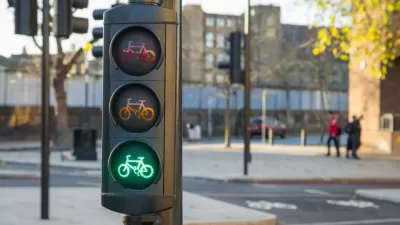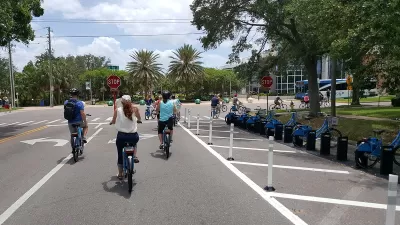Elisabeth Rosenthal reflects on the deterrent to cycling, and the use of bike-sharing systems, posed by mandatory bike helmet laws. Does the rare serious injury prevented by a helmet outweigh discouraging cycling's wider health benefits?
It turns out that mandatory helmet laws for bicyclists are largely peculiar to the United States, where the National Highway Traffic Safety Administration
recommends that "all cyclists wear helmets, no matter where they ride," and just a few other countries. In cities like Melbourne, Australia, where helmet use is mandatory, such laws may be contributing to the dismal use of its bike-sharing program, contends Rosenthal.
"One common denominator of successful bike programs around the world -
from Paris to Barcelona to Guangzhou - is that almost no one wears a
helmet, and there is no pressure to do so."
While helmets can prevent serious head injury in certain types of crashes, Rosenthal says that such falls are exceedingly rare in "mature urban cycling systems. On the other hand, many researchers say, if you force or pressure people
to wear helmets, you discourage them from riding bicycles."
"'Pushing helmets really kills cycling and bike-sharing in particular
because it promotes a sense of danger that just isn't justified - in
fact, cycling has many health benefits,' says Piet de Jong, a professor
in the department of applied finance and actuarial studies at Macquarie
University in Sydney. He studied the issue with mathematical modeling,
and concludes that the benefits may outweigh the risks by 20 to 1."
He adds: "Statistically, if we wear helmets for cycling, maybe we should
wear helmets when we climb ladders or get into a bath, because there
are lots more injuries during those activities."
FULL STORY: To Encourage Biking, Cities Lose the Helmets

Alabama: Trump Terminates Settlements for Black Communities Harmed By Raw Sewage
Trump deemed the landmark civil rights agreement “illegal DEI and environmental justice policy.”

Study: Maui’s Plan to Convert Vacation Rentals to Long-Term Housing Could Cause Nearly $1 Billion Economic Loss
The plan would reduce visitor accommodation by 25% resulting in 1,900 jobs lost.

Why Should We Subsidize Public Transportation?
Many public transit agencies face financial stress due to rising costs, declining fare revenue, and declining subsidies. Transit advocates must provide a strong business case for increasing public transit funding.

Paris Bike Boom Leads to Steep Drop in Air Pollution
The French city’s air quality has improved dramatically in the past 20 years, coinciding with a growth in cycling.

Why Housing Costs More to Build in California Than in Texas
Hard costs like labor and materials combined with ‘soft’ costs such as permitting make building in the San Francisco Bay Area almost three times as costly as in Texas cities.

San Diego County Sees a Rise in Urban Coyotes
San Diego County experiences a rise in urban coyotes, as sightings become prevalent throughout its urban neighbourhoods and surrounding areas.
Urban Design for Planners 1: Software Tools
This six-course series explores essential urban design concepts using open source software and equips planners with the tools they need to participate fully in the urban design process.
Planning for Universal Design
Learn the tools for implementing Universal Design in planning regulations.
Smith Gee Studio
Alamo Area Metropolitan Planning Organization
City of Santa Clarita
Institute for Housing and Urban Development Studies (IHS)
City of Grandview
Harvard GSD Executive Education
Toledo-Lucas County Plan Commissions
Salt Lake City
NYU Wagner Graduate School of Public Service




























